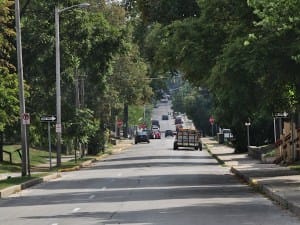Up to 44 more parking spaces now possible on Dunn Street

Residents won’t see the changes immediately, but Bloomington’s city council voted unanimously Wednesday night to approve an ordinance revision to allow for more parking on Dunn Street.

The ordinance change allows the street to be reduced to one travel lane.
The legislation approved by the council on Wednesday also revised a neighborhood permit parking zone boundary for residents who live on 17th Street.
The south side of 17th Street was added to the newly established neighborhood parking permit Zone 6, in the Garden Hill neighborhood, west of the Indiana University football stadium.
Dunn Street
Proposed Dunn Street parking changes drew enough questions from councilmembers Jim Sims and Isabel Piedmont-Smith last week (on Aug. 7) that the council decided to postpone consideration of the legislation until last night.
The legislation approved by the council eliminated some current no-parking restrictions on some blocks of Dunn Street. The street runs one-way south.
The blocks of Dunn between 6th and 10th would no longer have “no-parking signs.” The idea is to increase parking supply, and slow down traffic. According to the city’s planning and transportation staff, councilmember Steve Volan said, the stretch is widely regarded as something of a speedway.
On Wednesday, Volan said that he did not think the city’s staff would install parking spaces “tomorrow,” but the ordinance change would give the city flexibility to add parking.
On Wednesday a clearer picture of the proposal emerged. Between 6th and 7th streets on Dunn, meters would be installed—as many as 11 meters, Volan said. And north of 7th Street, as many as 33 spaces parallel-parking spaces could be installed.
Between 10th and 9th streets along Dunn, parking would be installed on the east side only, Volan said. Between 9th and 7th on Dunn, parking could be on both sides of the street. Between 7th and 6th, parking could be on both sides but would be metered. For that stretch, the east side already has meters.
Piedmont-Smith said on Wednesday she thinks allowing parking on Dunn Street is a good idea because there’s a premium on parking in the area—she also liked the side effect of traffic calming.
At the Aug. 7 meeting, councilmember Volan referred to a lengthy report on a study done for the planning and transportation department, which he offered to provide. The report concludes that the two lanes are not necessary for capacity, but rather provide a convenience for drivers.
The report is based on traffic counts done earlier in 2019, while schools were in session, at the intersections of 10th, 7th and 6th streets. In the morning peak hour, from 8 a.m. to 9 a.m. 120 vehicles were counted driving south from 10th to 9th. In the afternoon peak hour, from 5 p.m. to 6 p.m. 311 vehicles were counted in the same stretch.
The report analyzes traffic flow in terms of “level of service” (LOS), which is defined on a kind of academic A-to-F scale based on the amount of delay drivers experience.
A ≤10 secs
B >10 and ≤15 secs
C >15 and ≤25 secs
D >25 and ≤35 secs
E >35 and ≤50 secs
F >50 secs
For the current, two-lane configuration, the report analyzes Dunn Street’s LOS in the morning as grade A for all three intersections. Conversion to one travel lane would maintain a grade of A for morning LOS.
For the afternoon, the report analyzes Dunn Street’s current LOS as grade B for all three intersections. Conversion to one travel lane would maintain a grade of B for the 10th and the 7th intersections, but drop the grade to C for Dunn and 6th streets.
The report concludes that the stacks of cars (queue length) in a one-lane configuration would not have an impact on “upstream” intersections. From the report:
At the intersection of Dunn Street & 6th Street, the 95th percentile queue length for the southbound approach is anticipated to be 175 feet during the PM peak hour which is approximately seven (7) vehicles. The distance between 6th Street and 7th Street is 300 feet; therefore, no impacts are expected to occur with the upstream intersection.
The use of both southbound travel lanes with the current configuration is likely due to having the option to choose the next available lane, and not out of necessity to maximize throughput from a capacity standpoint. Although queuing is expected to be slightly longer during the PM peak hour as a one-lane roadway, Dunn Street is anticipated to continue to operate at an acceptable LOS without any significant impacts to corridor operations.
17th Street in Permit Zone 6
The change allows residents of single-family household detached dwellings on the south side of 17th Street to obtain a permit and park a vehicle on the street. Permits allow someone to park on a street in the neighborhood, but only where it’s otherwise allowed, which does not include 17th Street.

The creation of Zone 6 was one of several revisions to the city’s parking ordinance enacted by Bloomington’s city council at its Sept. 19 meeting last year, on a unanimous vote.
At last week’s meeting, councilmember Steve Volan said the idea to add 17th Street’s south side to the zone came from someone who lives on 17th Street, who has no off-street parking available and was accustomed to parking on Washington or Lincoln streets. Volan said he consulted with the neighborhood, and heard no objections. On Wednesday (Aug. 14), the 17th street issue was not debated.
The tally for the roll call vote on the parking ordinance revision looked like this:
| Motion | Sturbaum | Granger | Chopra | Rollo | Piedmont-Smith | Volan | Ruff | Sandberg | Sims |
| Parking: add 17th Street to residential zone; allow parking on Dunn | absent | yes | yes | yes | yes | yes | yes | yes | yes |




Comments ()